
The Himalayas of India: Ladakh and Dharamsala,
Summer 2008
Himachal Pradesh - Dal Lake, Chamba's Stone Temples
Page 10 of 16
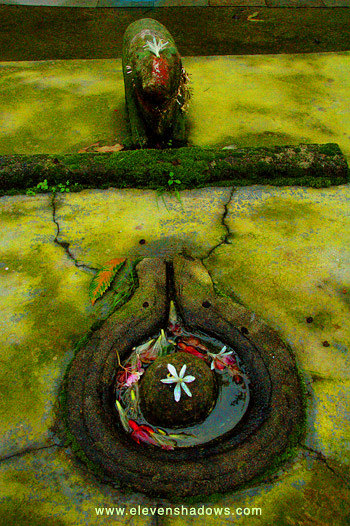 Dal
Lake is in a lovely opening in a pine forest However, the lake is also choked with
garbage, a huge ongoing problem in India. Dal
Lake is in a lovely opening in a pine forest However, the lake is also choked with
garbage, a huge ongoing problem in India.I saw an Indian man standing at the banks of the lake, gazing wistfully at the towering pines surrounding the lake and the spectacular Dhauladhar Mountains, a frozen tidal wave of rock. He gazed around the surroundings, then looked down at the water, dropped a candy wrapper in the lake, and walked off, fouling the very area that he had come to admire. I walked back to town, eating spring rolls and sweet lassis at McLlos, the restaurant that Pierce Brosnan stops by when he blows into McLeod Ganj, according to all their menus. McLlos probably has the best sweet lassis in town, and their masala dosas rival most anything you can get in South India, where I traveled with Lisa just three years ago. ~~~~ Lingam at the small Shiva temple overlooking Dal Lake. |
 I
shot this from my tiny hotel room at Ladies Home Venture, the rain caught
in the needles of a pine tree by the nunnery across
Jogibara Road. I
shot this from my tiny hotel room at Ladies Home Venture, the rain caught
in the needles of a pine tree by the nunnery across
Jogibara Road.~~~~ The Tibetan government-in-exile is arguably the most successful government-in-exile ever created. Despite the hardship, they've developed a community based on peace, spirituality, and global interdependence and unity here in Dharamsala, hardly the "backwards" and "barbaric" people that the Chinese say they are. And I realized, walking around and seeing Tibetans, Hindus, Nepalis, Punjabis, Sikhs, Biharis, and other people from all over the world interact, that Dharamsala was a microcosm of the sort of country that the Dalai Lama would create, were he to have a country. And while one can point out a great deal of ineptitude and misguided policy within the government-in-exile, they had largely succeeded in this model of unity and interdependence. And in a country such as India which embraced diversity, Dharamsala has been allowed to shine brightly. |
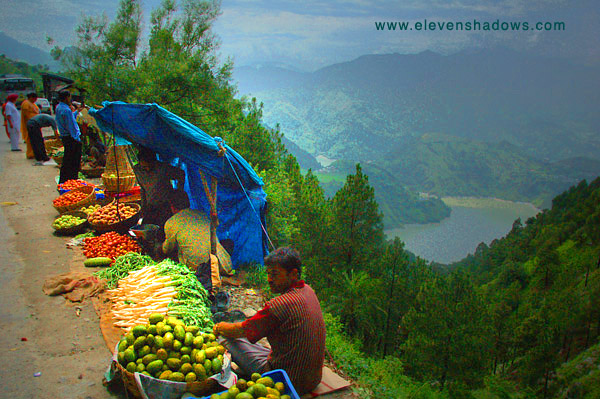 19
July - I
rode a bus to Dalhousie, then on to Chamba. The drive was spectacular,
hugging the mountains the whole way. Towering pine forests, rivers
below with large mountains in the middle, emerald-terraced paddies, and no
rain. On the way, we stopped off for tea and vegetables. 19
July - I
rode a bus to Dalhousie, then on to Chamba. The drive was spectacular,
hugging the mountains the whole way. Towering pine forests, rivers
below with large mountains in the middle, emerald-terraced paddies, and no
rain. On the way, we stopped off for tea and vegetables. |
 I
walked to Hotel Champak, a state-run hotel. It was dismal and
uninspiring, a disappointment for the usually clean state-run hotels. I
walked to Hotel Champak, a state-run hotel. It was dismal and
uninspiring, a disappointment for the usually clean state-run hotels.
Outside Hotel Champak, some kids said some derogatory words. I ignored them. Then they used Chinese slurs. I ignored them. They shouted the F-Bomb over and over and over, not stopping while I was trying to talk to someone. Finally, I pretended to chase them down the street, and they scattered. I found this bizarre, as this was my fifth trip to India, and nothing like this had ever happened before, However, this was to be the first of many encounters with nasty little children in Chamba. I walked across to MC Guest House. This was noticeably better, although still dingy. I booked it anyway, only to find that no one spoke English, forcing me to play charades for everything - towels, keys, laundry. |
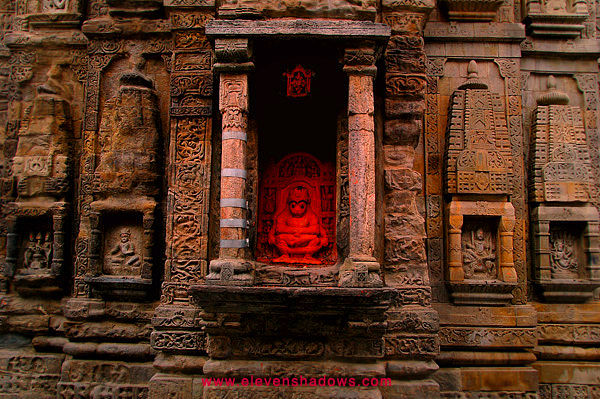 I
walked around the Chowgan to the Hariral Temple, a stone shikhara style
temple from the 11th Century. No one was there, and the historical
temple was surrounded by small, crappy apartments. The temple grounds
were small, and the temple intricate and beautiful. I
walked around the Chowgan to the Hariral Temple, a stone shikhara style
temple from the 11th Century. No one was there, and the historical
temple was surrounded by small, crappy apartments. The temple grounds
were small, and the temple intricate and beautiful. |
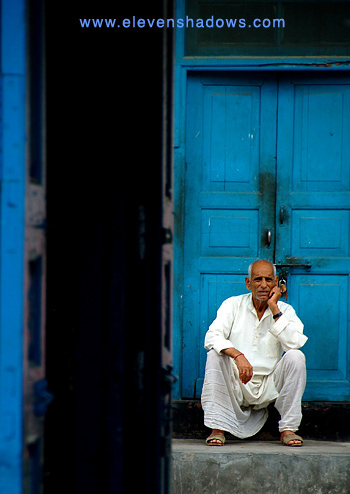 Chamba
was filled with temples. I walked up the steep Temple Road to the
Lakshmi (Laxmi) Narayan Temple Complex, its six temples all larger and most
more detailed than the Hariral Temple. Chamba
was filled with temples. I walked up the steep Temple Road to the
Lakshmi (Laxmi) Narayan Temple Complex, its six temples all larger and most
more detailed than the Hariral Temple.
Here, a man rests inside the temple complex. |
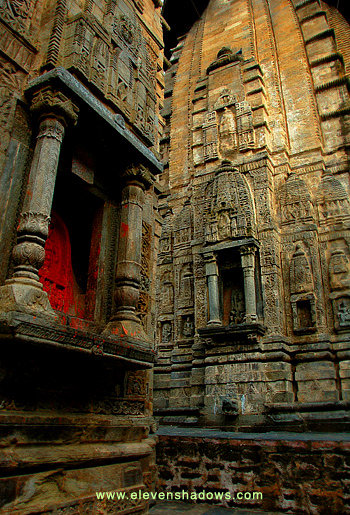 The
intricately carved stone temples here in Chamba struck me as tiny, miniature
versions of the astonishing
Ellora
and Ajanta Caves, which we had visited in 2005, although recognizing
that stylistically there were differences. The
intricately carved stone temples here in Chamba struck me as tiny, miniature
versions of the astonishing
Ellora
and Ajanta Caves, which we had visited in 2005, although recognizing
that stylistically there were differences.
|
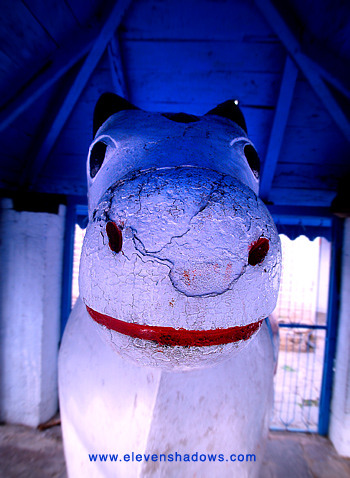 Bull
at the Lakshmi Narayan Temple Complex in Chamba. Bull
at the Lakshmi Narayan Temple Complex in Chamba. |
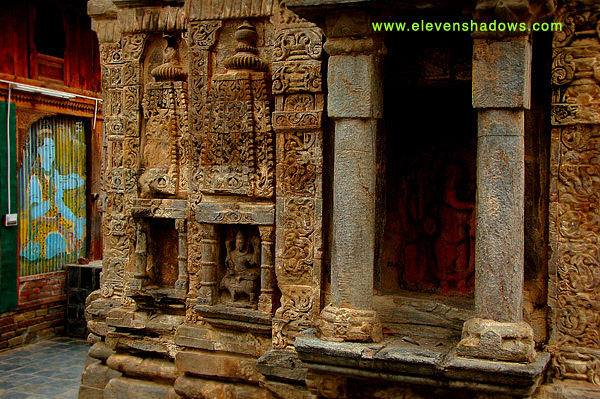 One
of the six temples in this complex, all exhibiting the exquisite shikhara
style, having distinctive elements only found in the Chamba Valley.
Three of the temples are devoted to Vishnu, and three to Shiva. All
were built in the 10th Century during the reign of the founder of Chamba,
Raja Sahil Varman, although extensively renovated in the 16th Century. One
of the six temples in this complex, all exhibiting the exquisite shikhara
style, having distinctive elements only found in the Chamba Valley.
Three of the temples are devoted to Vishnu, and three to Shiva. All
were built in the 10th Century during the reign of the founder of Chamba,
Raja Sahil Varman, although extensively renovated in the 16th Century. |
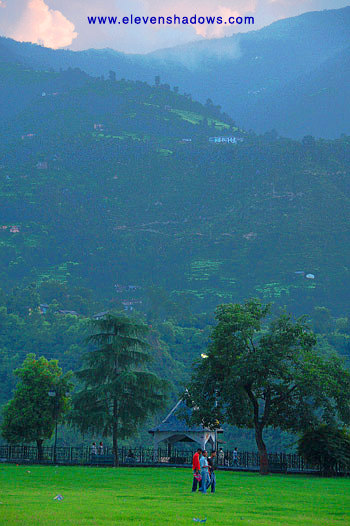 The
mountains of the Chamba Valley behind Chowgan and on the other side of the
Ravi River, at about 926m, are lower in elevation than Dalhousie or McLeod Ganj
(1700m), and noticeably hotter during the monsoon summers. Chowgan is a large park that with a
large concourse that is the hub of Chamba's activity. The
mountains of the Chamba Valley behind Chowgan and on the other side of the
Ravi River, at about 926m, are lower in elevation than Dalhousie or McLeod Ganj
(1700m), and noticeably hotter during the monsoon summers. Chowgan is a large park that with a
large concourse that is the hub of Chamba's activity. |
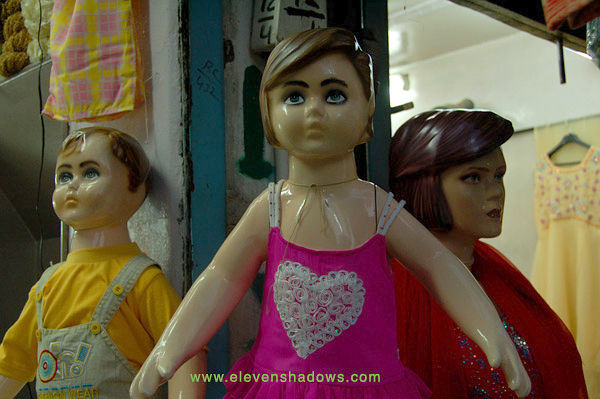 The
mannequins of Chamba. I like taking photos of mannequins. It's a
thing. The
mannequins of Chamba. I like taking photos of mannequins. It's a
thing.After walking around, I finally went back to my hotel. I had exhausted my fifteen-word Hindi vocabulary, the shower was miserable, and the room was dingy. I vowed to change to the much nicer Hotel Iravati the next day. |
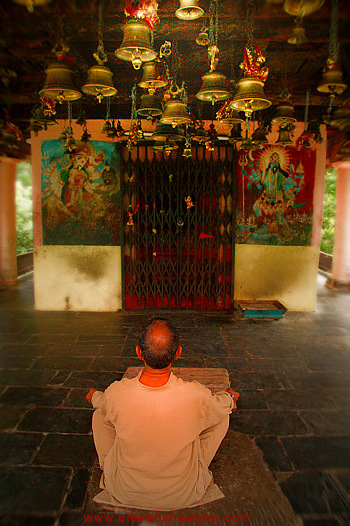 20
July - The first thing I did was collect my laundry, quite a task in itself,
and then shifted to the Hotel Iravati, taking a bright, open room with a balcony
overlooking the Chowgan. I already felt much better. Without
eating or packing, I immediately took off to the Chamunda Devi Temple,
devoted to a wrathful incarnation of Durga, perched on a hill overlooking
Chamba Valley. It was a hot, pleasant, steep climb, and I
gulped down an ice cold liter of water on my way up. 20
July - The first thing I did was collect my laundry, quite a task in itself,
and then shifted to the Hotel Iravati, taking a bright, open room with a balcony
overlooking the Chowgan. I already felt much better. Without
eating or packing, I immediately took off to the Chamunda Devi Temple,
devoted to a wrathful incarnation of Durga, perched on a hill overlooking
Chamba Valley. It was a hot, pleasant, steep climb, and I
gulped down an ice cold liter of water on my way up.When I arrived, there was a man finishing up his yoga exercises. He started asking some questions, eventually asking, "How tall are the highest mountains in America?" I said that Mt. Whitney was maybe about 4300m (actually, it's 4428m, almost 15000 ft., but not a bad guess) in the 48 states, and McKinley in Alaska was maybe 6000m (it's actually almost 6200m, just over 20000 ft.). He looked at me, seeming almost concerned in a grandfatherly way. "Is that all?" Another man meditated in front of the Chamunda Devi Temple underneath the brass bells. |
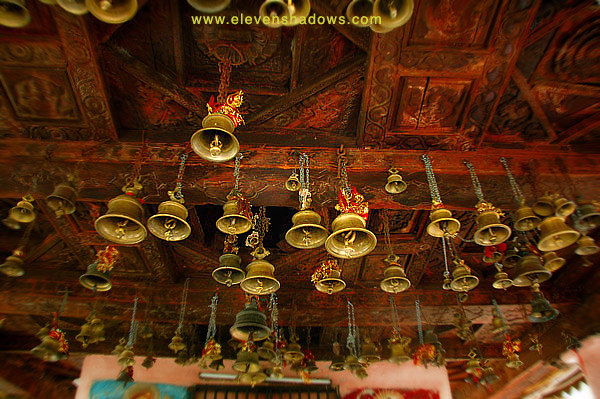 I
very quietly walked around the meditating man to photograph the suspended
brass bells and the intricately carved wood in the mandapa (forechamber) of
the Chamunda Devi Temple. I
very quietly walked around the meditating man to photograph the suspended
brass bells and the intricately carved wood in the mandapa (forechamber) of
the Chamunda Devi Temple. |
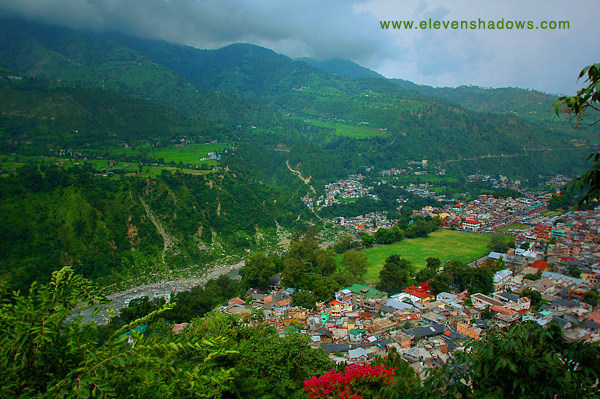 Chamba,
the Chowgan (the large grassy park), and the Ravi River as it looks
from the Chamunda Devi Temple, with dark clouds already starting to roll in. Chamba,
the Chowgan (the large grassy park), and the Ravi River as it looks
from the Chamunda Devi Temple, with dark clouds already starting to roll in. |
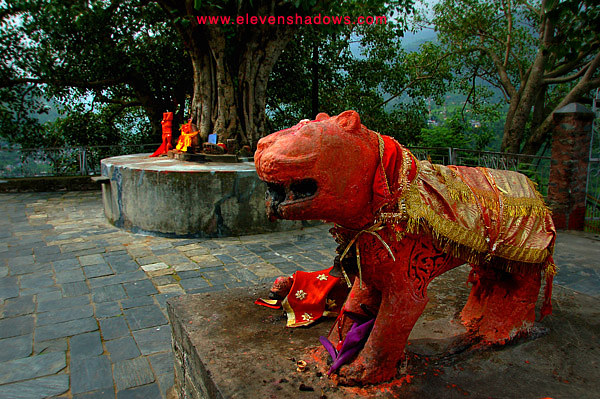 Chamunda
Devi Temple, high above Chamba. Chamunda
Devi Temple, high above Chamba. |
The Himalayas of India: Ladakh and Dharamsala, Summer 2008
Page 10 of 16
1 2 3 4 5 6 7 8 9 10 11 12 13 14 15 16
Eleven Shadows Travel Page
Contact photographer/musician Ken Lee